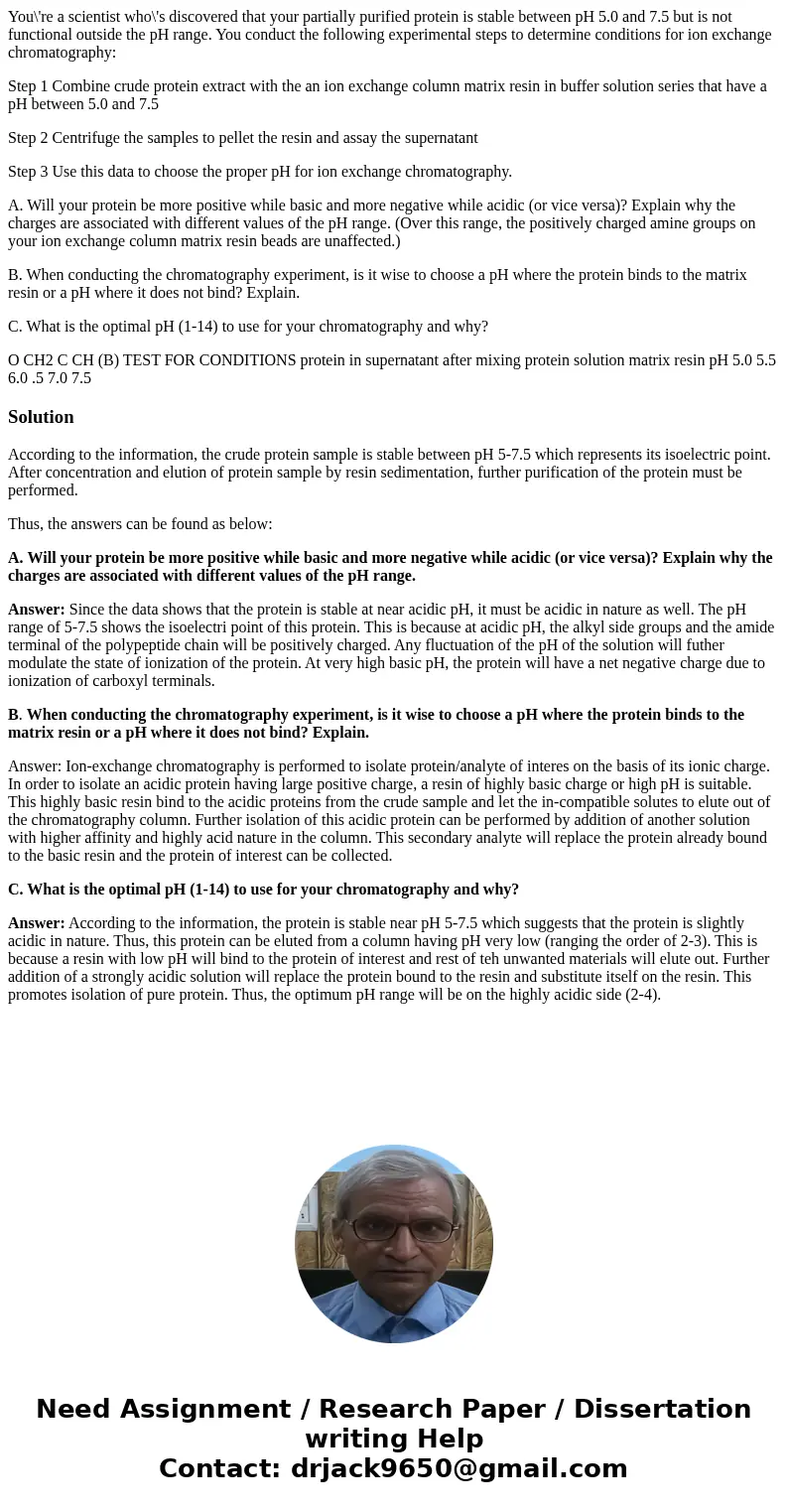Youre a scientist whos discovered that your partially purifi
You\'re a scientist who\'s discovered that your partially purified protein is stable between pH 5.0 and 7.5 but is not functional outside the pH range. You conduct the following experimental steps to determine conditions for ion exchange chromatography:
Step 1 Combine crude protein extract with the an ion exchange column matrix resin in buffer solution series that have a pH between 5.0 and 7.5
Step 2 Centrifuge the samples to pellet the resin and assay the supernatant
Step 3 Use this data to choose the proper pH for ion exchange chromatography.
A. Will your protein be more positive while basic and more negative while acidic (or vice versa)? Explain why the charges are associated with different values of the pH range. (Over this range, the positively charged amine groups on your ion exchange column matrix resin beads are unaffected.)
B. When conducting the chromatography experiment, is it wise to choose a pH where the protein binds to the matrix resin or a pH where it does not bind? Explain.
C. What is the optimal pH (1-14) to use for your chromatography and why?
O CH2 C CH (B) TEST FOR CONDITIONS protein in supernatant after mixing protein solution matrix resin pH 5.0 5.5 6.0 .5 7.0 7.5Solution
According to the information, the crude protein sample is stable between pH 5-7.5 which represents its isoelectric point. After concentration and elution of protein sample by resin sedimentation, further purification of the protein must be performed.
Thus, the answers can be found as below:
A. Will your protein be more positive while basic and more negative while acidic (or vice versa)? Explain why the charges are associated with different values of the pH range.
Answer: Since the data shows that the protein is stable at near acidic pH, it must be acidic in nature as well. The pH range of 5-7.5 shows the isoelectri point of this protein. This is because at acidic pH, the alkyl side groups and the amide terminal of the polypeptide chain will be positively charged. Any fluctuation of the pH of the solution will futher modulate the state of ionization of the protein. At very high basic pH, the protein will have a net negative charge due to ionization of carboxyl terminals.
B. When conducting the chromatography experiment, is it wise to choose a pH where the protein binds to the matrix resin or a pH where it does not bind? Explain.
Answer: Ion-exchange chromatography is performed to isolate protein/analyte of interes on the basis of its ionic charge. In order to isolate an acidic protein having large positive charge, a resin of highly basic charge or high pH is suitable. This highly basic resin bind to the acidic proteins from the crude sample and let the in-compatible solutes to elute out of the chromatography column. Further isolation of this acidic protein can be performed by addition of another solution with higher affinity and highly acid nature in the column. This secondary analyte will replace the protein already bound to the basic resin and the protein of interest can be collected.
C. What is the optimal pH (1-14) to use for your chromatography and why?
Answer: According to the information, the protein is stable near pH 5-7.5 which suggests that the protein is slightly acidic in nature. Thus, this protein can be eluted from a column having pH very low (ranging the order of 2-3). This is because a resin with low pH will bind to the protein of interest and rest of teh unwanted materials will elute out. Further addition of a strongly acidic solution will replace the protein bound to the resin and substitute itself on the resin. This promotes isolation of pure protein. Thus, the optimum pH range will be on the highly acidic side (2-4).

 Homework Sourse
Homework Sourse